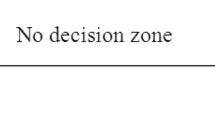Abstract
The double threshold based cognitive radio system is very efficient towards having the high detection probability but lacks in the proper utilization of the confused region between the two thresholds. This paper proposes an improved spectrum sharing (ISS) scheme which does not only provide the higher detection probability but also utilizes the confused region in a productive and risk-free manner. Moreover, the proposed scheme achieves better throughput than the conventional cognitive radio (CCR) system based on the single and double threshold, both. To further achieve the improved results, the proposed system has been analyzed for the case of novel cognitive radio system, where, the obtained results are found beyond the sensing-throughput tradeoff and are better than the CCR system. We have further implemented the ISS scheme under the cooperation of n-out-of-k CRs, this cooperative approach makes the proposed system robust enough towards the hidden terminal problem and “shadowing and fading” effects of the wireless communication channel.














Similar content being viewed by others
References
Federal Communications Commission. (2002). Spectrum policy task force report, FCC 02-155.
Mitola, J., & Maguire, G. Q. (1999). Cognitive radio: making software radios more personal. IEEE Personal Communications, 6, 13–18.
Mitola, J. (2000). Cognitive radio: An integrated agent architecture for software defined radio. PhD diss., Royal Inst. Technology, Stockholm, Sweden.
Haykin, S. (2005). Cognitive radio: Brain-empowered wireless communications. IEEE Journal on Selected Areas in Communications, 23, 201–220.
Liang, Y. C., Zeng, Y., et. al. (2007). Sensing throughput tradeoff for cognitive radio networks. In IEEE international conference on communications (ICC) (pp. 5330–5335).
Liang, Y. C., Zeng, Y., et al. (2008). Sensing throughput tradeoff for cognitive radio networks. IEEE Transactions on Wireless Communications, 7(4), 1326–1337.
Stotas, S., & Nallanathan, A. (2010). Overcoming the sensing-throughput tradeoff in cognitive radio networks. In IEEE international conference on communications (ICC) (pp. 1–5). doi: 10.1109/ICC.2010.5502792.
Stotas, S., & Nallanathan, A. (2012). On the throughput and spectrum sensing enhancement of opportunistic spectrum access cognitive radio networks. IEEE Transactions on Wireless Communications, 11(1), 97–101.
Pandit, S., & Singh, G. (2013). Throughput maximization with reduced data loss rate in cognitive radio network. Telecommunication Systems. doi:10.1007/s11235-013-9858-z.
Ghasemi, A., & Sousa, E. S. (2007). Fundamental limits of spectrum-sharing in fading environments. IEEE Transactions on Wireless Communications, 6(2), 649–658.
Musavian, L., & Aissa, S. (2007). Ergodic and outage capacities of spectrum-sharing systems in fading channels. In Proceedings of the IEEE global telecommunications (GLOBECOM) conference (pp. 3327–3331).
Stotas, S., & Nallanathan, A. (2011). Enhancing the capacity of spectrum sharing cognitive radio networks. IEEE Transactions on Vehicular Technology, 60(8), 3768–3779.
Kang, X., et al. (2009). Sensing based spectrum sharing in cognitive radio networks. IEEE Transactions on Vehicular Technology, 58(8), 4649–4654.
Wu, J., et al. (2009). An energy detection algorithm based on double-threshold in cognitive radio systems. In IEEE, 1st international conference on information systems engineering (ICISE) (pp. 493–496). doi: 10.1109/ICISE.2009.257.
Xie, J. Q., & Chen, J. (2012). An adaptive double-threshold spectrum sensing algorithm under noise uncertainty. In IEEE 12th international conference on computer and information technology (CIT) (pp. 824–827). doi: 10.1109/CIT.2012.171.
Liu, S.-Q., et al. (2012). Hierarchical cooperative spectrum sensing based on double thresholds energy detection. IEEE Communications Letters, 16(7), 1096–1099.
Zhu, J., et al. (2008). Double threshold energy detection of cooperative spectrum sensing in cognitive radio. In IEEE, cognitive radio oriented wireless networks and communications (CROWNCOM) (pp. 1–5). doi: 10.1109/CROWNCOM.2008.4562451.
Jafarian, J., & Hamdi, K. A. (2012). Throughput optimization in a cooperative double-threshold sensing scheme. In IEEE, wireless communications and networking (WCNC) (pp. 1034–1038). doi: 10.1109/WCNC.2012.6213925.
Zhang, W., & Lataief, K. B. (2008). Cooperative spectrum sensing with transmit and relay diversity in cognitive radio networks. IEEE Transactions on Wireless Communications, 7(12), 4761–4766.
Ghasemi, A., et al. (2005). Collaborative spectrum sensing for opportunistic spectrum access in fading environments. In Proceedings of 1st IEEE international symposium on new frontiers in dynamic spectrum access networks, Baltimore, USA, (pp. 131–136).
Wang, Y., et al. (2014). Optimization of cluster-based cooperative spectrum sensing scheme in cognitive radio networks with soft data fusion. Wireless Personal Communications. doi:10.1007/s11277-014-1673-7.
Sun, C. et al. (2007). Cooperative spectrum sensing for cognitive radios under bandwidth constraints. In Proceedings of IEEE wireless communications and networking conference, Hong Kong, China (pp. 1–5).
Zhang, W., et al. (2009). Optimization of cooperative spectrum sensing with energy detection in cognitive radio networks. IEEE Transactions on Wireless Communications, 8(12), 5761–5766.
Peh, E. C. Y., et al. (2009). Optimization of cooperative sensing in cognitive radio networks: a sensing-throughput tradeoff view. IEEE Transactions on Vehicular Technology, 58(9), 5294–5299.
Author information
Authors and Affiliations
Corresponding author
Rights and permissions
About this article
Cite this article
Verma, G., Sahu, O.P. Improved Spectrum Sharing (ISS) Scheme for Cognitive Radio Networks. Wireless Pers Commun 96, 2323–2340 (2017). https://doi.org/10.1007/s11277-017-4300-6
Published:
Issue Date:
DOI: https://doi.org/10.1007/s11277-017-4300-6




